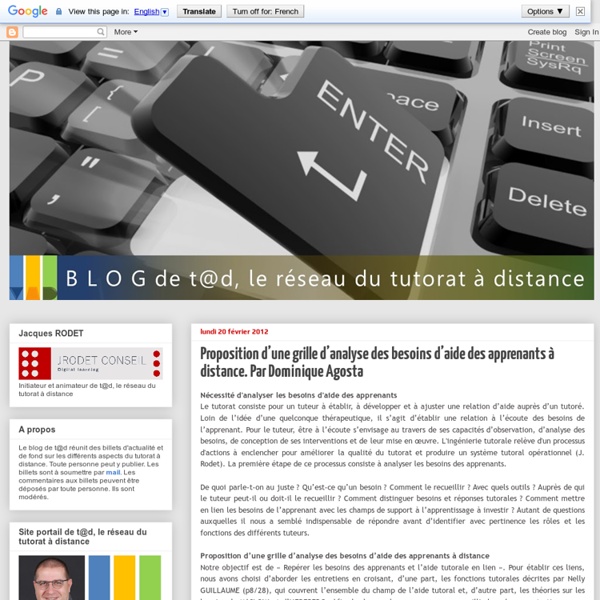



http://blogdetad.blogspot.com/2012/02/proposition-dune-grille-danalyse-des.html
Related: MOOC - UCL • Apprendre à apprendre • Tutorat de FOADActivité 7.4 - Tutorat en ligne This site uses some unobtrusive cookies to store information on your computer. Some cookies on this site are essential, and the site won't work as expected without them. These cookies are set when you submit a form, login or interact with the site by doing something that goes beyond clicking on simple links. We also use some non-essential cookies to anonymously track visitors or enhance your experience of the site. If you're not happy with this, we won't set these cookies but some nice features of the site may be unavailable.Some cookies on this site are essential, and the site won't work as expected without them.
The Secret to Student Success? Teach Them How to Learn. Sometimes the details former students recall from class is nothing short of amazing. A few years ago I had a student named Abby in my history class, who had always been in self-contained special education classrooms. Her teacher wanted her in my class for socialization purposes, and she did well. A year later, Abby began stopping by my class to deliver notes from the office a few times a week and I was always delighted to see her. One day I had been planning to discuss metacognition—a learning strategy I teach to my middle-school students.
Online social networks as formal learning environments: Learner experiences and activities George Veletsianos and Cesar C. Navarrete University of Texas at Austin, USA Abstract While the potential of social networking sites to contribute to educational endeavors is highlighted by researchers and practitioners alike, empirical evidence on the use of such sites for formal online learning is scant. To fill this gap in the literature, we present a case study of learners’ perspectives and experiences in an online course taught using the Elgg online social network. Activité 7.2 - peeragpgy It is tempting to bring a list of technologies out as a glorious cookbook. We need a 1/2 cup of group writing tools, 2 tsp. of social network elements, a thick slice of social bookmarking, and some sugar, then put it in the oven for 1 hour for 350 degrees. We have created a broad features/functions list for Handbook readers to reflect upon and consider. The joy of this list is that you can consider alternatives for the way you communicate and work while you are planning the project, or can add in new elements to solve communications gaps or create new tools. However, too many tools spoil the broth. In the writing of this Handbook, we found that out firsthand.
Publications — LRN Allaire-Duquette, G., Belanger, M., Grabner, R. H., Koschutnig, K., & Masson, S. (2019). Individual differences in science competence among students are associated with ventrolateral prefrontal cortex activation. Journal of Neuroscience Research, 97(9), 1163-1178. doi:10.1002/jnr.24435 Teaching time investment: Does online really take more time than face-to-face? Rebecca Van de Vord and Korolyn Pogue Washington State University, USA Abstract Enrollments in online programs are growing, increasing demand for online courses. The perception that teaching online takes more time than teaching face-to-face creates concerns related to faculty workload. To date, the research on teaching time does not provide a clear answer as to the accuracy of this perception.
Activité 6.4 - Learning by Peer Review SWoRD. SWoRD is a web-based reciprocal peer review system. In less fancy terms, students turn their class papers into SWoRD, which then assigns this paper to four to six peers in the class. The peers grade the paper and give advice for how to improve it. Simple Ways to Integrate Four Evidence-Based Teaching Strategies When educators understand the science behind teaching practices they can more readily incorporate them into their daily instruction, says Cult of Pedagogy’s Jennifer Gonzalez. In her podcast and accompanying post, Gonzalez highlights the four key teaching strategies researcher that Pooja Agarwal and K–12 teacher Patrice Bain feature in their new book, Powerful Teaching: Unleash the Science of Learning. They explain the science behind the suggestions, many of which are familiar, as well as best practices and applications for each one.
8 Ideas, 10 Guides, And 17 Tools For A Better Professional Learning Network Personal learning networks are a great way for educators to get connected with learning opportunities, access professional development resources, and to build camaraderie with other education professionals. Although PLNs have been around for years, in recent years social media has made it possible for these networks to grow exponentially. Now, it’s possible to expand and connect your network around the world anytime, anywhere. But how exactly do you go about doing that? Check out our guide to growing your personal learning network with social media, full of more than 30 different tips, ideas, useful resources, and social media tools that can make it all possible.